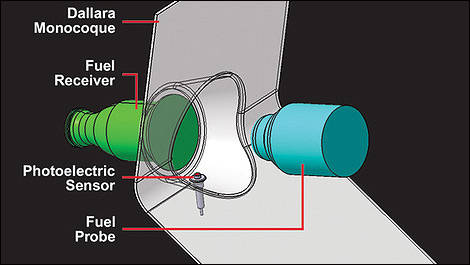


https://www.youtube.com/watch?v=bpxtmSY9Blc
RSI theory currently applied in IndyCar Series as a safety refuelling method to avoid fuel spilling in case of fire. F1 should apply that theory if refuelling in F1 reintroduced.
Every year, as a result of human error or mechanical malfunction, there are instances of drivers leaving their pit boxes with the refueling hose attached to the car. All of these incidents create the potential for a fire in the pits and injuries to the driver, crew members, or others in the pit-lane area. It was just such an incident – one that resulted in serious injuries during an Hockenheim F1 race in 1994, Singapore F1 race in 2008 and Brazil F1 race in 2009 – that led to the development of this system.
The system is designed to reduce the potential for pit fires and injuries resulting from drivers leaving their pit boxes with refueling equipment still attached.
At the heart of the system is a fuel-probe electronic sensor, installed in the refueling "buckeye" – or inlet valve – on an every F1 chassis. When the sensor detects a connection between the pit-lane refueling nozzle and the buckeye, software in the Engine Control Unit signals the Gearbox Control Unit to place, or hold, the transmission in ‘Neutral’, and prevents the driver from leaving the pit lane before the refueling hose is detached from the car.
Sequence of Operation
1. Car comes into pits and stops for refueling. Refueling nozzle is inserted.
2. Photoelectric sensor in fuel "buckeye" detects engagement of refueling nozzle.
3. Engine Control Unit (ECU) commands Gearbox Control Unit (GCU) to shift and hold transmission in neutral.
4. All paddle-shift requests are ignored during refueling.
5. Refueling is complete; nozzle is removed and no longer detected by the sensor.
6. Driver can now select first gear and leave the pits.
